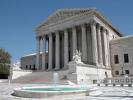Limits to Life: SCOTUS Issues Decision in Graham
The Supreme Court finally issued its long-awaited decision in Graham v. Florida this morning. And it turns out that the Eighth Amendment may not be so toothless after all: the Court held that sentencing a juvenile to life without parole for a nonhomicide crime violates the Cruel and Unusual Punishment Clause. Graham received an LWOP sentence for a botched robbery at age sixteen. The Court overturned Graham’s sentence, holding that states must at least “give defendants like Graham some meaningful opportunity to obtain release based on demonstrated maturity and rehabilitation” (24). Thus, the Court did not preclude life sentences per se for juveniles, but rather focused on the availability of parole:
The Eighth Amendment does not foreclose the possibility that persons convicted of nonhomicide crimes committed before adulthood will remain behind bars for life. It does forbid States from making the judgment at the outset that those offenders never will be fit to reenter society. (24)
Graham breaks a string of defeats in the Court for Eighth Amendment challenges to prison terms. Although the Court has been quite active in recent years in using the Eighth Amendment to regulate the death penalty, the Court had seemed uninterested in imposing limitations on the use of lesser sentences. Of course, LWOP for a juvenile robbery is pretty extreme, so it would be premature to infer from Graham that the Court is going to get more involved in regulating long prison terms.
Not suprisingly, Justice Kennedy authored the majority opinion. He has been the swing Justice in the Court’s recent Eighth Amendment cases, and there was little doubt that he was going to be part of the majority in Graham whichever way it came out. Slightly more surprising is that Chief Justice Roberts concurred in the judgment, making the final vote 6-3 (instead of the more typical 5-4 in Eighth Amendment cases). Based on this and a few other recent cases (for instance, with respect to jury-trial rights), it seems to me that Roberts is not as much an automatic vote against defendants as his predecessor, Chief Justice Rehnquist. It is also interesting to see the Justice Sotomayor voted with the majority, suggesting that she may adhere to the position of her predecessor (Justice Souter) in supporting robust Eighth Amendment rights. Would a Justice Kagan do the same? Justice Stevens was part of several tenuous majorities in this area, meaning that his replacement has the potential to bring about some major changes in the Court’s Eighth Amendment jurisprudence.


